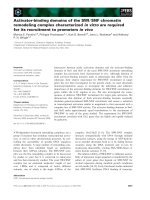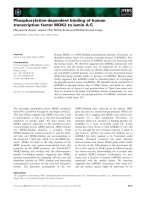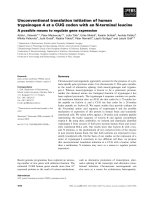HOW TO WRITE A SCIENTIFIC RESEARCH? LÀM THẾ NÀO VIẾT ĐƯỢC 1 BÁO CÁO KHOA HỌC
Bạn đang xem bản rút gọn của tài liệu. Xem và tải ngay bản đầy đủ của tài liệu tại đây (100.69 KB, 21 trang )
COLLEGE COMPOSITION
PROF.,DR. NGUYEN PHAN THIET
VIETNAM FORESTRY UNIVERSITY
3.3. SCIENTIFIC REPORT
A. SCIENTIFIC ARTICLE
TT
Module
Layout
of
a scientific
Article
MODULE
CONTENTS
1
Module 1 Introduction
2
3
4
Module 2 Research History
Module 3 Research Objectives
Module 4 Scientific issues and the Author's
Thesis
5
Module 5 Research methods and arguments
to prove thesis
6
7
Module 6 Research results Analysis
Module 7 Conclusions & Recommendations
1.1.Module 1: Introduction
• Reasons of Research
• Theoretical and practical significance of the study
• Who benefits from the research results
1.2. Module 2: Research History (Who did?)
• Brief Description of study Process; Achievements and Authors
• Strengths and weaknesses of Previous Researches
• Conclusions about the content to be solved
1.3. Module 3: Research Objectives (What will I do?)
• The long-term work plan
• The immediate work to be done
• Illustrating on the target tree
1.4.Module 4: Issues of research and the author's thesis (What’s
my thesis?)
•
•
Issues (questions) that exist in the research and issues the author
mentioned in the study
Arguments of various authors and the arguments of the author of the
article itself.
1.5. Module 5: Methods and Arguments to prove the thesis
•
•
Theoretical basis (theoretical arguments) and the method used.
The practical arguments and methods used: observation, interviews,
surveys, experiments or tests.
1.6. Module 6: Analysis of results
•
•
•
The difference between the actual and the assumptions set out in the
observations/experiments.
The accuracy of the measurement and the bias of the observation
The limitations of the information gathering process and the ability to
pass
1.7. Module 7: Conclusions and recommendations
• CONCLUSIONS
General evaluation of the results obtained.
Affirm the strengths, weaknesses of the arguments and
methods; Since then, the affirm or negative confirmed
correctness of arguments.
Acknowledge the contribution of theory.
Predicted results apply
• RECOMMENDATIONS
• Recommendations about Additions of theory.
• Recommendation about application of the results.
• Recommendations for further research guide.
B. SCIENCE THESIS
© DIFINITIONS
• Scientific Thesis is a monograph on a scientific topic or
technology by science researcher for the following
purposes:
Train of scientific research methods and skills
Demonstrating the results of a study phase
Protection in front of the thesis committee
• Thus: Scientific Thesis is a scientific research Work or a
scientific research Probationary, recorded a mark of the
author’s strives
© TYPES OF THESIS
• Bachelor Thesis: a general monograph of the student after
ending training program at the University to obtain a
bachelor's degree
• Master Thesis: a scientific monograph that presents a
systematic study of graduate students to gain master’s
degree
• Ph.D. thesis: a scientific monograph that presents
systematically a science topic of PhD. Candidate to protect
for gaining PhD’s degree
© ESTABLISHING A RESEARCH OUTLINE OF THE THESIS
TYPE 1
1-Part 1, Thought of the study, including the following contents:
•
•
•
•
•
•
•
•
Reasons to choose the thesis (why I choose this topic?)
History of the research (Who did what in this area?)
Objectives (ie, tasks) research (Will do?)
Object (where would I do?, What a social community will I do?)
Scope of the study (Area to do?)
Scientific issues (questions should be answered in the study?)
Hypothesis (What is my basic argument?)
Proving Methods :
proving by Theories, ie, given "theoretical basis"
experiment
Justification of results
• Conclusion and recommendation about the results.
•
2- Part 2, outline of the thesis, includes the following chapters:
• Beginning Chapter
Reasons for research
History of research
Subjects of study
Scope of Research
Research hypothesis and methods of proving the hypothesis
• Chapter 1
About the contents for proving the hypothesis (ie scientific
arguments) by theory: what concepts should need to clarify?,
what type of science that its theory basis is used to prove the
hypothesis .
3. Chapters 2, 3, 4 ...
• Introduction to proving part by methods of practical observation,
expert interviews, scientific conferences and experiment
• This chapter can be divided into some chapters depending on
practical research activities.
4. Conclusions and recommendations
TYPE2
•
® COMPONENT 1
•
•
•
•
•
•
•
Front cover
Title page
Dedication (optional)
Abstract
Acknowledgements (optional)
Table of contents
List of symbols, abbreviations
(if needed)
List of tables and figures
® COMPONENT 2
• Introduction
• Literature Review
• Materials and Methods or
Methodology.
• Results
• Discussion
• Conclusions and
Recommendations
References
Appendices
• ABSTRACT
Maximally one page
No literature references
• TABLE OF CONTENTS
Automatically generated by
WORD
Avoid too much sub-splitting
of the chapters
• INTRODUCTION
Serves to attract the
reader’s attention
Be brief and to the point
Start broad scope of
research, then become
more specific
End with aims/objectives of
the study
• LITERATURE REVIEW
•
•
Literature survey on your and
related topics
Integration of literature
Not all literature you have read
should be in
Do not copy large text
fragments. If copy,
give correct reference (avoid
plagiary)
MATERIALS AND METHODS
Be systematic and precise, so
that others can exactly copy your
experiments
Follow logic, chronological
order (sampling,
preservation, analysis, data
handling)
For standard procedures,
refer to literature
Include information on type
of equipment, chemicals etc.
Correct chemical names,
species names (in Latin
and in italics), use SI system
• RESULTS
Comprehensive and
coherent on its own
Do not present literature
Indicate what the results
are showing
Negative results are also
results!
Relate text logically with
Tables/Figures
Present in clear
tables/figures
Not too much
information at one time
Graphs are preferred
above tables
Include appropriate
statistical parameters
Detailed tables of all
data Appendices
• DISCUSSION
Preferably separate from
results
Critically discuss your
own results, also in
relation with existing
literature
Most difficult part
Not necessarily follow the
order of the results; choose
your own logic
Refer to tables and figures in
results, but do not repeat the
Results section
Dare to discuss your own
idea
• CONCLUCTION AND
RECOMMENDATIONS
List the main conclusions
Limit yourself
(maximally 4)
Two types of
recommendations
For further studies
For advise to externals
(e.g. politicians)
• REFERENCES
Use Harvard style:
In text: surnames + year
In reference list:
alphabetically
• Double check:
All literature in text ► also in
reference list
All items in reference list ►
also in text
Be consistent
Use endnote
• APPENDIX
For all information not
directly relevant
• Unprocessed results
• Detailed description of
a model
• Interview reports
• .....
• GENERAL REMARKS
•
•
•
•
BS reports are not Lecture
Notes. Be concise!
Length is not related to quality.
Start to make framework first
with “working title” and table of
contents.
Use your spell check. Your
mentor will not do the English
corrections.
What to do with comments of
supervisors?
• WHERE TO START?
List all literature (you have read) in correct way
Material & Methods
Results: Figures & Tables; Text
Discussion
Conclusions & Recommendations
Introduction
Abstract
3.4. FORM AND STRUCTURE OF THESIS
•
•
•
•
•
Cover
Thank giving Page
Table of Contents
Symbol and Abbreviations
Foreword
The reason and context of thesis
Theoretical and practical Meaning of The topic
Achievements and problems
The next scheduled work
• Overview
General introduction to the research Topic
Overview of research history and the selection of research Topic
A brief about research Implimentations
• Theoretical Basics and Research Methods
Theoretical basis used, including the inherited theoretical basis and
basis of self-build theory
Describing the research methods that were implemented
• Content and outcomes research (can present in a number
of programs)
Hypothesis and methods for proving hypothesis
The results on theoritical and practical sides
Analysis of results and addressing unresolved issues.
• Conclusion and recommendation
• Reference
• Appendix









